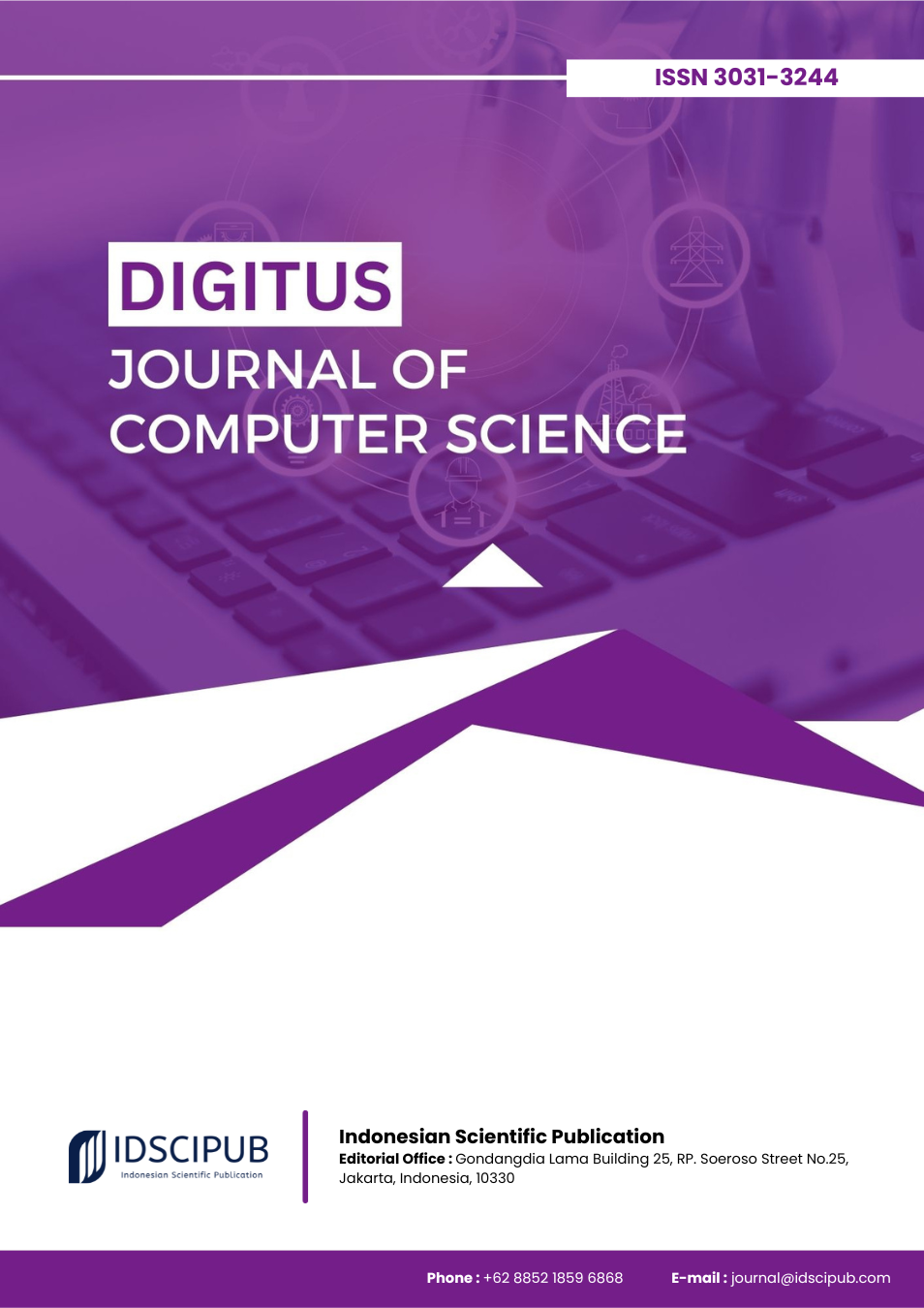Ethical and Technical Frameworks for Deploying Honeypots in Public Wireless Networks
DOI:
https://doi.org/10.61978/digitus.v2i1.750Keywords:
Honeypots, WLAN Security, Intrusion Detection, Snort, Cybersecurity Policy, Public Networks, Attack SimulationAbstract
Public Wireless Local Area Networks (WLANs) in government and public service institutions are highly vulnerable to cyberattacks, yet conventional firewalls and intrusion detection systems (IDS) often fail to provide proactive defense. This study aims to evaluate the effectiveness of honeypot-based security within the WLAN infrastructure of Dinas Perpustakaan dan Kearsipan Kota Pekanbaru. Using an applied experimental design, honeypots were integrated with Snort IDS and visualized through Honeymap to capture attacker behavior, detect anomalies, and benchmark detection performance. The results show that honeypots reduced detection latency, lowered false positives, and improved accuracy in identifying port scanning and brute force attacks compared to standard firewalls. Additionally, Honeymap enabled geographic analysis of attack origins, enhancing situational awareness. The findings highlight not only the technical benefits but also ethical challenges, particularly regarding user privacy and informed consent. This research recommends that public institutions adopt clear governance frameworks, ensure regular staff training, and maintain continuous system updates to sustain honeypot effectiveness. Strategically deployed, honeypots can strengthen cybersecurity readiness and inform policy development in public network environments.
References
Adigwe, C., Mayeke, N., Olabanji, S., Okunleye, O., Joeaneke, P., & Olaniyi, O. (2024). The evolution of terrorism in the digital age... https://doi.org/10.9734/ajeba/2024/v24i31287 DOI: https://doi.org/10.9734/ajeba/2024/v24i31287
Adnan, M., Just, M., Baillie, L., & Kayacık, H. (2015). Investigating the work practices of network security professionals... https://doi.org/10.1108/ics-07-2014-0049 DOI: https://doi.org/10.1108/ICS-07-2014-0049
Akhriana, A. and Irmayana, A. (2019). Web app pendeteksi jenis serangan jaringan komputer... https://doi.org/10.33050/ccit.v12i1.604 DOI: https://doi.org/10.33050/ccit.v12i1.604
Al-Abassi, A., Karimipour, H., Dehghantanha, A., & Parizi, R. (2020). An ensemble deep learning-based cyber-attack detection... https://doi.org/10.1109/access.2020.2992249 DOI: https://doi.org/10.1109/ACCESS.2020.2992249
Alawi, M., Alsaqour, R., Abdalla, A., Abdelhaq, M., & Uddin, M. (2021). Multi-criteria prediction mechanism for vehicular wi-fi offloading... https://doi.org/10.32604/cmc.2021.018282 DOI: https://doi.org/10.32604/cmc.2021.018282
Alyas, T., Alissa, K., Alqahtani, M., Faiz, T., Alsaif, S., Tabassum, N., … & Naqvi, H. (2022). Multi-cloud integration security framework using honeypots... https://doi.org/10.1155/2022/2600712 DOI: https://doi.org/10.1155/2022/2600712
Asad, H. and Gashi, I. (2018). Diversity in open source intrusion detection systems... https://doi.org/10.1007/978-3-319-99130-6_18 DOI: https://doi.org/10.1007/978-3-319-99130-6_18
Balbin, D. and Lascano, E. (2023). Pandemic narratives of library and information centers in baguio-benguet... https://doi.org/10.1108/dlp-01-2023-0004 DOI: https://doi.org/10.1108/DLP-01-2023-0004
Castro-Toledo, F., Esteve, M., & Llinares, F. (2019). Fear of cybercrime... https://doi.org/10.31235/osf.io/kx26n DOI: https://doi.org/10.31235/osf.io/kx26n
Chandy, S., Rasekh, A., Barker, Z., & Shafiee, M. (2019). Cyberattack detection using deep generative models... https://doi.org/10.1061/(asce)wr.1943-5452.0001007 DOI: https://doi.org/10.1061/(ASCE)WR.1943-5452.0001007
Chen, B., Παππάς, Ν., Chen, Z., Yuan, D., & Zhang, J. (2019). Throughput and delay analysis... https://doi.org/10.1109/access.2019.2897017 DOI: https://doi.org/10.1109/ACCESS.2019.2897017
Choi, J. (2020). Detection of misconfigured wi-fi tethering... https://doi.org/10.20944/preprints202002.0189.v1 DOI: https://doi.org/10.20944/preprints202002.0189.v1
Coyac-Torres, J., Sidorov, G., Anaya, E., & Hernández-Oregón, G. (2023). Cyberattack detection in social network messages... https://doi.org/10.3390/make5030058 DOI: https://doi.org/10.3390/make5030058
De-lu, L. (2023). Exploring the path of network security and student privacy protection... https://doi.org/10.2478/amns.2023.1.00001 DOI: https://doi.org/10.2478/amns.2023.1.00001
Faldi, F., Romadoni, D., & SUMADI, M. (2023). The implementation of network server security system... https://doi.org/10.33387/jiko.v6i2.6385 DOI: https://doi.org/10.33387/jiko.v6i2.6385
Faramondi, L., Flammini, F., Guarino, S., & Setola, R. (2021). A hardware-in-the-loop water distribution testbed dataset... https://doi.org/10.1109/access.2021.3109465 DOI: https://doi.org/10.1109/ACCESS.2021.3109465
Ficke, E., Schweitzer, K., Bateman, R., & Xu, S. (2019). Analyzing root causes of intrusion detection false-negatives... https://doi.org/10.1109/milcom47813.2019.9020860 DOI: https://doi.org/10.1109/MILCOM47813.2019.9020860
Gainforth, H., Baxter, K., Baron, J., Michalovic, E., Caron, J., & Sweet, S. (2019). Re-aiming conferences... https://doi.org/10.1186/s12961-019-0434-1 DOI: https://doi.org/10.1186/s12961-019-0434-1
Holt, T., Griffith, M., Turner, N., Greene‐Colozzi, E., Chermak, S., & Freilich, J. (2023). Assessing nation‐state‐sponsored cyberattacks... https://doi.org/10.1111/1745-9133.12646 DOI: https://doi.org/10.1111/1745-9133.12646
Husni, E. and Kurniati, Y. (2014). Application of mean time-to-compromise... https://doi.org/10.1109/tssa.2014.7065960 DOI: https://doi.org/10.1109/TSSA.2014.7065960





